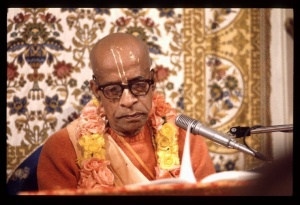SB 5.22.2: Difference between revisions
m (1 revision(s)) |
(Vanibot #0018 edit: make synonym terms in Sanskrit italic in SB - Vanisource) |
||
| Line 1: | Line 1: | ||
{{info | {{info | ||
|speaker= | |speaker=Śukadeva Gosvāmī | ||
|listener=King | |listener=King Parīkṣit | ||
}} | }} | ||
[[Category:Srimad-Bhagavatam - Canto 05 Chapter 22|s02 ]] | |||
[[Category:Bhagavatam Verses Spoken by Sukadeva Gosvami - Vanisource|052202]] | |||
<div style="float:left">'''[[Srimad-Bhagavatam]] - [[SB 5|Fifth Canto]] - [[SB 5.22: The Orbits of the Planets|Chapter 22: The Orbits of the Planets]]'''</div> | |||
<div style="float:right">[[File:Go-previous.png|link=SB 5.22.1]] '''[[SB 5.22.1]] - [[SB 5.22.3]]''' [[File:Go-next.png|link=SB 5.22.3]]</div> | |||
{{RandomImage}} | |||
==== TEXT 2 ==== | ==== TEXT 2 ==== | ||
<div | <div class="verse"> | ||
sa hovāca | :sa hovāca | ||
yathā kulāla-cakreṇa bhramatā saha bhramatāṁ tad-āśrayāṇāṁ pipīlikādīnāṁ gatir anyaiva pradeśāntareṣv apy upalabhyamānatvād evaṁ nakṣatra-rāśibhir upalakṣitena kāla-cakreṇa dhruvaṁ meruṁ ca pradakṣiṇena paridhāvatā saha paridhāvamānānāṁ tad-āśrayāṇāṁ sūryādīnāṁ grahāṇāṁ gatir anyaiva nakṣatrāntare rāśy-antare copalabhyamānatvāt | :yathā kulāla-cakreṇa bhramatā saha bhramatāṁ tad-āśrayāṇāṁ | ||
:pipīlikādīnāṁ gatir anyaiva pradeśāntareṣv apy upalabhyamānatvād evaṁ | |||
:nakṣatra-rāśibhir upalakṣitena kāla-cakreṇa dhruvaṁ meruṁ ca pradakṣiṇena | |||
:paridhāvatā saha paridhāvamānānāṁ tad-āśrayāṇāṁ sūryādīnāṁ grahāṇāṁ | |||
:gatir anyaiva nakṣatrāntare rāśy-antare copalabhyamānatvāt | |||
</div> | </div> | ||
| Line 14: | Line 24: | ||
==== SYNONYMS ==== | ==== SYNONYMS ==== | ||
<div | <div class="synonyms"> | ||
''saḥ''—Śukadeva Gosvāmī; ''ha''—very clearly; ''uvāca''—answered; ''yathā''—just as; ''kulāla-cakreṇa''—a potter's wheel; ''bhramatā''—turning around; ''saha''—with; ''bhramatām''—of those turning around; ''tat-āśrayāṇām''—being located on that (wheel); ''pipīlika-ādīnām''—of small ants; ''gatiḥ''—the motion; ''anyā''—other; ''eva''—certainly; ''pradeśa-antareṣu''—in different locations; ''api''—also; ''upalabhyamānatvāt''—due to being experienced; ''evam''—similarly; ''nakṣatra-rāśibhiḥ''—by the stars and signs; ''upalakṣitena''—being seen; ''kāla-cakreṇa''—with the great wheel of time; ''dhruvam''—the star known as Dhruvaloka; ''merum''—the mountain known as Sumeru; ''ca''—and; ''pradakṣiṇena''—on the right; ''paridhāvatā''—going around; ''saha''—with; ''paridhāvamānānām''—of those going around; ''tat-āśrayāṇām''—whose shelter is that wheel of time; ''sūrya-ādīnām''—headed by the sun; ''grahāṇām''—of the planets; ''gatiḥ''—the motion; ''anyā''—other; ''eva''—certainly; ''nakṣatra-antare''—in different stars; ''rāśi-antare''—in different signs; ''ca''—and; ''upalabhyamānatvāt''—due to being observed. | |||
</div> | </div> | ||
| Line 21: | Line 31: | ||
==== TRANSLATION ==== | ==== TRANSLATION ==== | ||
<div | <div class="translation"> | ||
Śrī Śukadeva Gosvāmī clearly answered: When a potter's wheel is moving and small ants located on that big wheel are moving with it, one can see that their motion is different from that of the wheel because they appear sometimes on one part of the wheel and sometimes on another. Similarly, the signs and constellations, with Sumeru and Dhruvaloka on their right, move with the wheel of time, and the antlike sun and other planets move with them. The sun and planets, however, are seen in different signs and constellations at different times. This indicates that their motion is different from that of the zodiac and the wheel of time itself. | Śrī Śukadeva Gosvāmī clearly answered: When a potter's wheel is moving and small ants located on that big wheel are moving with it, one can see that their motion is different from that of the wheel because they appear sometimes on one part of the wheel and sometimes on another. Similarly, the signs and constellations, with Sumeru and Dhruvaloka on their right, move with the wheel of time, and the antlike sun and other planets move with them. The sun and planets, however, are seen in different signs and constellations at different times. This indicates that their motion is different from that of the zodiac and the wheel of time itself. | ||
</div> | </div> | ||
__NOTOC__ | |||
<div style="float:right; clear:both;">[[File:Go-previous.png|link=SB 5.22.1]] '''[[SB 5.22.1]] - [[SB 5.22.3]]''' [[File:Go-next.png|link=SB 5.22.3]]</div> | |||
__NOTOC__ | |||
__NOEDITSECTION__ | |||
Revision as of 01:51, 1 December 2017

A.C. Bhaktivedanta Swami Prabhupada
TEXT 2
- sa hovāca
- yathā kulāla-cakreṇa bhramatā saha bhramatāṁ tad-āśrayāṇāṁ
- pipīlikādīnāṁ gatir anyaiva pradeśāntareṣv apy upalabhyamānatvād evaṁ
- nakṣatra-rāśibhir upalakṣitena kāla-cakreṇa dhruvaṁ meruṁ ca pradakṣiṇena
- paridhāvatā saha paridhāvamānānāṁ tad-āśrayāṇāṁ sūryādīnāṁ grahāṇāṁ
- gatir anyaiva nakṣatrāntare rāśy-antare copalabhyamānatvāt
SYNONYMS
saḥ—Śukadeva Gosvāmī; ha—very clearly; uvāca—answered; yathā—just as; kulāla-cakreṇa—a potter's wheel; bhramatā—turning around; saha—with; bhramatām—of those turning around; tat-āśrayāṇām—being located on that (wheel); pipīlika-ādīnām—of small ants; gatiḥ—the motion; anyā—other; eva—certainly; pradeśa-antareṣu—in different locations; api—also; upalabhyamānatvāt—due to being experienced; evam—similarly; nakṣatra-rāśibhiḥ—by the stars and signs; upalakṣitena—being seen; kāla-cakreṇa—with the great wheel of time; dhruvam—the star known as Dhruvaloka; merum—the mountain known as Sumeru; ca—and; pradakṣiṇena—on the right; paridhāvatā—going around; saha—with; paridhāvamānānām—of those going around; tat-āśrayāṇām—whose shelter is that wheel of time; sūrya-ādīnām—headed by the sun; grahāṇām—of the planets; gatiḥ—the motion; anyā—other; eva—certainly; nakṣatra-antare—in different stars; rāśi-antare—in different signs; ca—and; upalabhyamānatvāt—due to being observed.
TRANSLATION
Śrī Śukadeva Gosvāmī clearly answered: When a potter's wheel is moving and small ants located on that big wheel are moving with it, one can see that their motion is different from that of the wheel because they appear sometimes on one part of the wheel and sometimes on another. Similarly, the signs and constellations, with Sumeru and Dhruvaloka on their right, move with the wheel of time, and the antlike sun and other planets move with them. The sun and planets, however, are seen in different signs and constellations at different times. This indicates that their motion is different from that of the zodiac and the wheel of time itself.